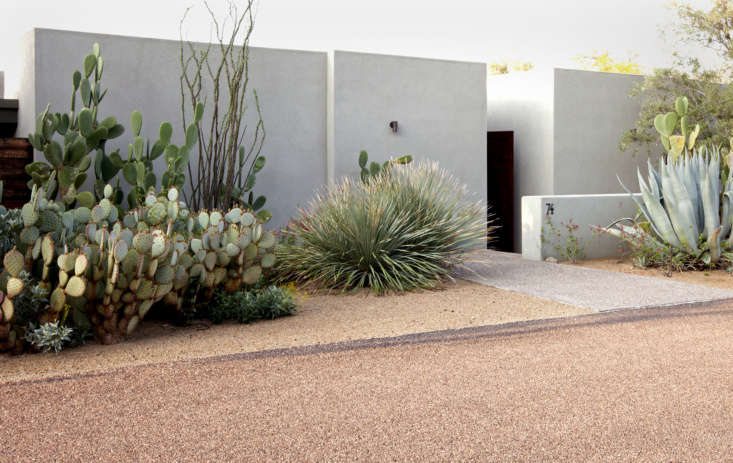Desert landscapes look like the backdrops in old cartoons, endless loops showing a lone cactus silhouetted against the sky while Road Runner and Wile E. Coyote tussle in the dusty foreground.
The starkness also can be romantic, a reminder of the endless western horizon. But if you live in the desert, how do you design a garden that feels welcoming instead of prickly and dry?
For advice, we turned to Phoenix-based landscape architect Steve Martino, who grew up in arid, rocky terrain. As a teenage horse wrangler, he developed an affinity for desert landscapes and native plants that has informed his work for four decades.
“One day I found all these old issues of Arizona Highways from the forties, featuring these guest dude ranches, desert resorts,” he says. The pictures were crazy, with plants that were just so dramatic, natives transplanted from the desert. They didn’t have all the stuff you get these days from nurseries from somewhere else. It was like a stage setting. That’s the feeling I try to create.”
Martino has collected 21 of his favorite landscape projects in a new book called Desert Gardens of Steve Martino (Monacelli Press). Here are 10 garden design tips for how to embrace the natural theatricality of the desert, illustrated with photos from the book.
Photography by Steve Gunther, courtesy of The Monacelli Press.
Cactus Curb Appeal

Entry walls or a front garden fence are a natural backdrop for specimen plants, says Martino. To create curb appeal with cactus, plant Choyas. There are 1,200 plants in the family, and you can go for ones that are trees, ground covers, shrubs,” says Martino. “Use them to create shadows. In the photo, you can see how these guys create their own depth and darkness even in the harsh sun.”
Sculptural Rocks

In the Scottsdale garden, Martino simplified hardscape elements, including a terrace and swimming pool (“removing distracting elements such as the boulder-lined, “lagoon-style” pool and its heavy wrought-iron railings”).
During the process, Martino removed an “exotic cactus” entryway garden that felt out of place, “and moved the exotic cactus around the corner in-between some rocks to make a little home for them.” The result is an unmistakably charming vignette beneath a mesquite tree (“The tree is a native, so it’s OK,” says Martino).
Filtered Light

To create the translucent wall, rolls of polycarbonate were stretched across a trellis framework. The wall is softened by the silhouette of a grapevine that grows on top. (See more ways to use polycarbonate panels in Garden Hacks: 10 Ideas Under $100 to Create Instant Privacy.)
“You can use trees and shadows and filtered light to make a garden feel comfortable and cool,” says Martino.
Before you build a privacy wall in a small garden, know your local zoning rules, Martino advises. “Say you’re only allowed to build a six-foot-high privacy wall. But if you build an accessory building—like a shed that’s under 200 square feet—you don’t have to have a building permit. And without a permit, there’s no schedule to finish the shed. Suddenly what you’ve built is the first wall of a shed in progress instead of an illegally high privacy fence.”
Ribbon Driveways

In a desert climate where rain is scarce and rainwater tends to run off the hard, rocky surface of the earth, a permeable surface is a friendlier alternative to pavement.
Whitewashed Walls

To complement the architecture of the adobe house, Martino designed an “old-fashioned” pool, a shoebox with straight sides and square corners. “We usually do darker swimming pools, which act more like a mirror of the sky, but in this one the tile is white and the color of the water is the reflection of the sky and daylight,” says Martino.
Layered Plantings

“Here we tried to use native, southwestern plants that would have been available 100 years ago to make the garden look authentic to the era when the house was built,” says Martino. “The cactus on right-hand side of the photo was two feet high when we planted it.”
Martino frequently creates a layered look with succulents and cacti rather than trees because “sometimes trees get taller than you want,” he says. “Sometimes you only want a plant to grow up to 15 feet and then stop because there are mountains in the distance above that height.”
Ocotillo Rib Fencing

“Ocotillo is a really historic material; ranchers and settlers made fences out of it a hundred and fifty years ago,” says Martino. “The old saying was that you could throw one of these out on the road for a few months and then pick it up and plant it and it still would be able to grow. Which is not true. But you can see in this photo that some of the ocotillo plants have leaves on them. They’ve re-sprouted.”
Tropical Colors

Adding to the tropical feeling are “leafy plants, lots of them,” says Martino. “You don’t see through this garden. There are succulents, and cactus, as well, and chairs under trees. It doesn’t look arid like the desert; it looks like an oasis.”
Water Fountains

The fountain set in a waterfall-blue wall, is visible from the clients’ living room, offering cooling views of running water on even the hottest day.
Striking Specimens

A diverse plant family, Agaves have sculptural silhouettes. Look for cultivars with striking foliage, Martino recommends. Variegated leaves can be “yellow with green on the edges, green with white edges, or like these with green with yellow edges,” says Martino. “They are quite an interesting family.”

- Can This Garden Be Saved: “It Barely Rains; I Live in a Desert”
- Escape to a Desert Garden, Pasadena Edition
- Letter from California: Lotusland Survives Fire and Fury in Montecito
- One Bedroom, Desert View: A Tiny Casita in Mexico, Swimming Pool Included













Have a Question or Comment About This Post?
Join the conversation (2)